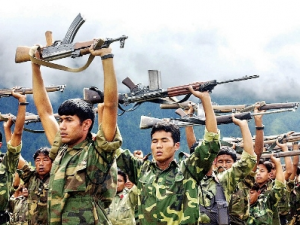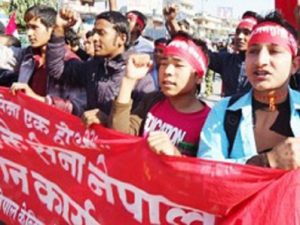by Jitman Basnet
On Nov. 22, 2006, after ten years of violent conflict in Nepal, the Nepal Government and Communist Party of Nepal (Maoist) signed a peace agreement. A new constitution based on federalism, justice for conflict victims, and transformations in the old state mechanisms in the judicial, economic, social, cultural, and political sectors are major parts of the peace process, and were all included in the 2006 peace agreement to be implemented within an initial two-year time frame. During the five-year period since the peace process began, none of these tasks have been accomplished.
In accordance with the peace deal, 19,600 Maoist fighters were confined in 28 cantonments in different parts of Nepal, awaiting possible integration into a newly formed National Army. Over the years, Nepal has been facing great challenges in its peace process, especially in terms of army integration, which is one of the major aspects of the process. This has created divisions within the Maoist Party. On Nov. 1, 2011, the present government (headed by a Prime Minister from the Maoist Party, Baburam Bhattarai) and the other major political parties signed a peace deal known as the four-point agreement. After the four-point deal, the Madheshi parties agreed to join in the Maoist-led government, but the deal has led to factionalization among the Maoists. One faction of the Maoists is currently in power as part of a coalition government, thus further exacerbating the rift in the Party.

Since the formation of Dr. Bhattarai’s government, the hardliner faction of the Unified Communist Party Maoist “Baidhya Group” has been expressing its dissatisfaction over the four-point agreement carried out with the Madheshi Morcha. The Madheshi parties continue to pressure the government to include more of the Madheshi community in the armed forces, while the government continues to insist on a few openings at a time.
In the last week of December 2011, a group of commanders in the Maoist Army tabled a memorandum to the Prime Minister showing their dissatisfaction over the four-point agreement carried out on November 1. As part of this agreement, major political parties including the Nepali Congress agreed to accept 6,500 Maoist fighters into the Nepal Army. However, more than 10,000 fighters have already been listed as wanting to join the Nepal Army during the “regrouping process,” whereby combatants choose integration, rehabilitation, or voluntary retirement. This process began Nov. 18, 2011. Following this agreement, which decided the number of fighters as well as criteria for recruitment and a financial package for voluntarily discharged fighters, dissatisfaction mounted in the Maoist Army.
On Dec. 27, 2011, “disqualified” former combatants of the Maoist army who were discharged from the cantonments after the verification of the United Nations Mission in Nepal (UNMIN) protested against the government and the Maoist leaders in Itahari, in southeastern Nepal. 4,008 of these were combatants discharged from the cantonments in 2010 after the UNMIN’s verification process. On Dec. 25, 2011, former Maoist combatants staged a demonstration against the UCPN (Maoist) leadership in Nepalgunj, a southwestern city in the Terai region (the southern part of Nepal near the Indian border). Hundreds of former combatants joined the rally and chanted slogans against the Maoist leadership and the United Nations for categorizing them as “disqualified” and depriving them of any benefits. They also warned of a return to armed struggle if their demands were not met. From time to time, these militarily trained fighters have been demonstrating their dissatisfaction, but the government and political parties are ignoring them. These “disqualified” fighters could join groups advocating violence and their military skills and history could contribute to renewed conflict in the future if their demands are not met.

The constitution drafting process, another major aspect of the peace process, has been stalled for a couple of months since the sub-committee formed by the Constitutional Assembly to sort out the major differences between the political parties has failed to produce an agreement. As per the recent verdict of the Nepali Supreme Court, the final deadline and terms of the Constitutional Assembly has been set for May 28, 2012. It is unclear what will happen to the Constitutional Assembly after this date. Questions about the future of the Constitutional Assembly are a major matter of conversation in the streets of Kathmandu these days. Within five months, the Constitutional Assembly will have to finalize the final draft of the constitution, finding a consensus on twenty-one major differences among political parties.
In the ten years of conflict, more than 16,000 Nepali people were killed. Of these, around 65 percent were killed extrajudicially. Ninety percent of the killings were committed by the government and ten percent by the rebels. According to the International Red Cross, 1,300 civilians disappeared and their whereabouts remain unknown. Several thousand people were internally displaced and hundreds were illegally arrested, tortured, and detained in secret military barracks or police custody. The victims of conflict have not received justice and none of the perpetrators have been prosecuted. The 2006 Peace Agreement speaks strongly about justice for these victims. According to the Peace Agreement, the Disappearance Commission and the Truth and Reconciliation Commission should have been set up within sixty days from the agreement’s signing date on Nov. 22, 2006, but as of yet neither of the Commissions has been formed. Instead of punishment, many of the perpetrators have been awarded and promoted by the government. In May 2007, the Supreme Court of Nepal gave a detailed verdict and recommended the promulgation of an appropriate law to address conflict related cases. Hundreds of victims have been awaiting justice, but no such law has yet been endorsed and no action has been taken against the human rights violators. Most of the perpetrators are still in powerful, decision-making positions.
Instead of finalizing the peace settlement, leaders of major political parties have been speaking against the peace process and creating more obstacles. After the successful People’s Uprising Movement and the signing of the Peace Agreement, most of the major political parties formed their own fighter groups (youth organizations), which have been involved in kidnapping, extortion, killings, and social crimes. According to the Home Ministry of Nepal, 109 criminal gangs are functioning in the Terai in the name of and with the support of political parties. They are also involved in criminal activities and human rights abuses. In the hill region, some ethnic groups have been involved in violent activities in the name of federalism, claiming their own ethnic states. In some parts of Nepal, there is still no government presence. The Rule of Law is weakening and most criminal gangs are affiliated with political parties and receive amnesty. Because the entire system is in transition, security is deteriorating. If this situation continues in Nepal, it will further affect the Peace Process.
Due to growing differences among the political parties and internal divisions in the Maoist Party, the peace process is at risk. After analyzing these circumstances and the political situation, we can conclude that there are dark clouds looming in Nepal. Everyone is curious about the future of Nepal and what will happen after the May 2012 deadline. The new Constitution and changes in the state mechanisms are equally important to keep the peace process on track. If one of these major aspects cannot be fulfilled, it will threaten peace in the country. The progress of the peace process or lack thereof defines the future of Nepal. India, China, and the U.S. are key international powers influencing Nepal’s internal politics. The international community has a duty and an interest in guiding Nepal’s peace process in a positive direction.
Jitman Basnet is a human rights lawyer and journalist who has been working in human rights and transitional justice in Nepal for 12 years. Because of his stand against violence, which involved him filing many cases against army officials who had committed human rights violations, he was kidnapped and tortured by Maoist rebels in 2002 for one day. In 2004 he was illegally arrested by the Royal Nepal Army and kept in secret custody for 258 days, subjected to extreme torture because of his voice for human rights and justice. Mr. Basnet is a founder and Secretary General of the Lawyers’ Forum For Human Rights (LAFHUR), a pro-bono lawyers’ network working in transitional justice and human rights in Nepal. LAFHUR provides free legal services to victims of human rights violations, especially women, children, and the poor who do not have access to justice. He is the author of 258 Dark Days, an account of his experiences in military custody.
 Advocating for nonviolent change, the Center for Conflict Studies emphasizes research and practice to better understand conflicts and manage them effectively in order to bring changes to current inequalities and social injustices. Our magazine, Reflections, will be published in annually.
Advocating for nonviolent change, the Center for Conflict Studies emphasizes research and practice to better understand conflicts and manage them effectively in order to bring changes to current inequalities and social injustices. Our magazine, Reflections, will be published in annually.

